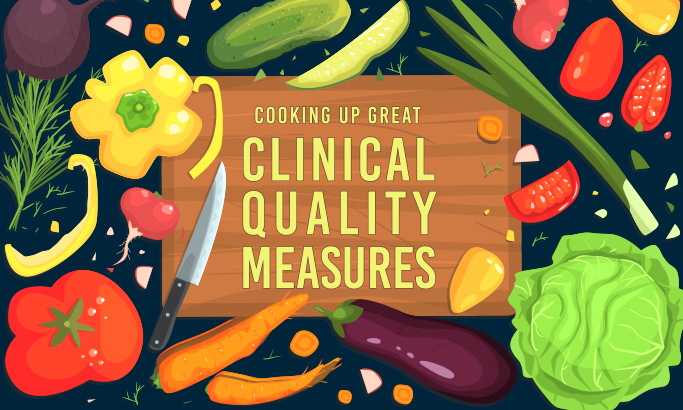Cooking Up Great Clinical Quality Measures

What makes for a great clinical quality measure? My conversational answer is that it’s a lot like a great recipe. Just like a recipe you love, a great clinical quality measure relies on tasty ingredients and your skill at making it. And you know a recipe is really successful when you’re willing to make it again, even when others grow tired of it. The same is true of clinical quality measures. (Stay with me!)
Cooking came to mind as I was reading a recent research letter in the Journal of the American Medical Association. The researchers identified 2,266 quality measures in CMS’ inventory of quality measures within its various performance-based reimbursement programs. About one-third of the measures are in use, about one-third are in development and the final third have never been used or have been retired.
The food in our refrigerators, freezers and pantries can act as metaphors for clinical quality measures. We use some ingredients consistently to cook our favorite recipes. We may use others just some of the time. Others we use only rarely. The reasoning behind our cooking habits is similar to that of the reasoning behind the three buckets of clinical quality measures that researchers in the JAMA study identified. I’ll explain why in a minute.
Where clinical quality measures come from
First, let’s talk about where clinical quality measures come from. Some are organic. They grow naturally from within a healthcare organization, such as a hospital, health system or medical group, that decides it wants to measure its own performance.
Most measures, especially recently, have been cultivated by external organizations that want to hold health systems or other providers accountable for patient outcomes or quality of care. These entities could be payers like CMS or accrediting bodies like The Joint Commission. Regulatory compliance, linkage to payments and public reporting are some of the levers used in these implementations.
How to cook up a clinical quality measure
Similar to various meals, some quality measures are easy to make, and some are much harder. Either way, they all start with a recipe, in this case a “specification.” If you want to develop a measure for CMS, the recipe needs to follow a formal process outlined in the “Blueprint for the CMS Measures Management System.” Version 15.0, the latest 450-page blueprint, was released in September 2019. By following the guide, developers ensure their measures meet the criteria (and recipe!) that CMS uses in its evaluation.
Medisolv recently followed some of the key blueprint components to develop and implement the industry’s first COVID-19 electronic clinical quality measure (eCQM) that helps hospitals measure and monitor their in-hospital mortality rates for COVID-19 patients.
What makes a quality measure a recipe worth repeating?
Just following the CMS blueprint doesn’t necessarily make for an effective quality measure, just as following a recipe doesn’t necessarily make for a great meal.
Let’s say someone gives you a recipe and says it will be the best meal you’ll ever eat. Exciting, right? Well, the recipe proves to be complicated. It calls for all kinds of rare ingredients, has dozens of steps and requires a complex table setting. But you follow it, and it really does turn out as promised: It’s the best meal ever. In that case, you’d be happy to go to the trouble of preparing the same meal again as the outcome is worth the effort.
Similarly, if the quality measure specification is complicated because it of its ingredients—complex calculation logic, data elements culled from patient records (some of which can be difficult to retrieve), and clinical documentation—providers are unlikely to use it unless it clearly results in better patient outcomes.
In other words, quality measurement is all about feasibility and value for two key stakeholders: patients and their care providers.
Retiring and creating new quality measures
There are many reasons payers and accrediting agencies shelve measures from their programs. Most commonly, they’re retired due to changes in clinical guidelines or if the cost of implementation exceeds the realized benefits. Often times, though, they’re retired because they were so effective. Yes, you read that right. Measures can actually become ineffective, especially in payment linked programs, if most participants have achieved such high enough scores that there is no longer any performance variation to improve. New measures are subsequently developed to address existing gaps in care or to address other outcomes of relevant interest, like the recent focus on social determinants of health and equity.
Some people ask me if I have a favorite quality measure. That’s like asking a foodie to name their best meal ever. It’s nearly impossible. That being said, I am a big fan of properly risk-adjusted, meaningful outcomes measures that can leverage the rapidly evolving digital infrastructure without adding a data collection burden on already overstretched providers.
While structure and process measures are important, patients value outcomes most. As an industry, outcomes are the standard we should hold ourselves to. Those recipes may be more challenging, but everyone will end up satisfied.
Learn more about how Medisolv developed and implemented the industry's first eCQM for COVID-19.
STAY AHEAD OF THE QUALITY CURVEQuality reporting requirements are always changing. Help keep your hospital ahead of the quality curve. Here are some resources you may find useful. Infographic: "The Five Stages of Health Care Data Quality Maturity" |






Comments